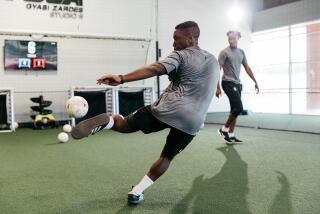Smart sports devices aim to step up performance
- Share via
The wearables revolution that’s transforming watch into smartwatch is also bringing the microchip to sports gear, with fascinating results. Smart rackets, smart basketballs, smart bike helmets, even a smart music-and-dance composer augment your workout with real-time feedback and advice that was simply impossible to get before. The result: better performance and creativity almost in an instant.
Tennis pro
Babalot Aeropro Pure Drive “Play” models: “Smart” tennis racket that electronically tracks the speed, spin and strings-placement of your forehands and backhands and sends it to your cellphone. It does this via a stealthy microprocessor, battery, altimeter, gyroscope, sensors and USB port embedded invisibly in the handle and frame.
Likes: It can help you more than any coach, almost instantly. The highly detailed feedback on your cellphone screen, transmitted from the racket via the tap of a Bluetooth button on the bottom of the handle, is simply beyond the capability of human eyes and stunning in its detail. Example: During my first 14 minutes of hitting, just 23% of my forehands had topspin (22 of 97 shots) at an average speed of 48 mph. Topspin and higher placement in the sweet spot allow you to hit harder and more accurately; in the next 18 minutes, I raised my topspin ratio to 39% (46 of 118 shots) and speed to 53 mph. Best of all, now I knew what I had to do. It was exhilarating to improve so quickly, with no apparent downside. The system adds no weight. It has been approved for pro tour use. Play models weigh the same as Babalot’s three regular Aeropro models: Lite (9.2 ounces), Team (9.9) and the Drive (10.6). More data will be added as the free app improves. It’s not really expensive; the added premium is basically the cost of a couple of tennis lessons. Now you get lessons for the rest of your life.
Dislikes: None.
Price: $299-$349. babolat.us
Shoots and scores
94Fifty basketball: Smart basketball that provides immediate audio and visual feedback on shooting and ball-handling skills through inertial motion sensors that connect with a smartphone app. It measures shooting arc, shot backspin, shot-release speed and dribble intensity.
Likes: This will make you a better shooter by improving shot rotation and arc. Its voice told me to add more trajectory to my shots (“38 degrees is a little flat; the ideal range is 42 to 48 degrees”) and bend my knees more as I shoot; I did — and improved. The ball is regulation size, weight and bounce. You must input your height and a shot distance you will practice from. It goes into auto-sleep after five minutes of inactivity and claims eight hours of continuous battery life. The free app keeps a history for up to four players. It includes a wireless charging pad and carry bag.
Dislikes: Expensive. You have to play with phone in your pocket and while wearing ear buds. It does not recognize if the shot is made or missed.
Price: $148.99-$399.95 on Amazon. 94fifty.com
Dancing sensation
Phonotonic: A 4-inch plastic geodesic ball that instantly turns anyone into a dancer and music composer. A motion sensor inside tracks your hand and body movement, and sends it to an app on your phone that converts it into music in real time — without a conventional instrument in sight.
Likes: Incredibly fun, whether used to compose music, get a little exercise or just elevate your mood around the house. You can’t help but dance with one or two of these in your hands; separate balls can be used to play a melody, beats and sound effects. Grabbing two balls — one for drums, the other for guitar-style instrumentation — I suddenly morphed into Mean Gene the Dancing Machine.
When you move fast or slow, so does the music, letting you create impromptu compositions. The app allows you to select music genres in the Phonotonic catalog, including rock, jazz and funk. The sensor can be removed from the ball and placed in other objects, even your socks.
Dislikes: None, except that it is available only online now and shipped from France.
Price: About $120, including shipping. phonotonic.net
Head and heart
Lifebeam bio-sensing bike helmet: A helmet that reads your heart rate and provides calorie burn data, eliminating the need for a conventional wrist-top heart-rate monitor with a chest strap. The same technology appears in Lifebeam ski goggles, hats and visors.
Likes: Invisible, comfortable, convenient. A tiny optical sensor contact is built into the helmet’s headband. It connects to your smartphone via Bluetooth or ANT+. The battery (rated to last up to 15 hours) charges via a USB port in the rear, with a 1.5-inch status light-strip glowing blue when charging or turned on by pressing a hidden button. Lifebeam doesn’t come with its own app; it pairs with Suunto, Polar, Garmin and more, and with numerous iOS and Android apps. The helmet, a modified Lazer Genesis, includes the excellent Rollsys adjustment thumb-wheel for a perfect fit. While not light (about 13.5 ounces, heavier than the regular Genesis by 25%), it feels comfortable.
Dislikes: Another thing to remember to charge. You can’t wear a cap under your helmet. You have to return the helmet to Israel if there are problems. It doesn’t do enough; heart-rate watches are loaded with data this doesn’t have. Why not a built-in LED safety light?
Price: $229. life-beam.com
Wallack is the co-author of “Bike for Life: How to Ride to 100.” [email protected]






